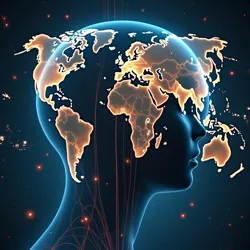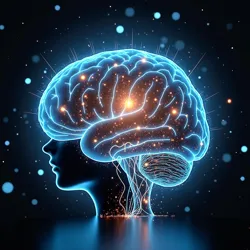Trans-Cultural Consciousness
 A visualization of global trans-cultural consciousness patterns showing interconnected thought streams across traditional cultural boundaries (2165)
A visualization of global trans-cultural consciousness patterns showing interconnected thought streams across traditional cultural boundaries (2165)Trans-cultural consciousness represents a fundamental shift in human cognitive and social organization that emerged in the mid-22nd century following the widespread adoption of direct neural interfaces and the establishment of global thought-sharing networks. This phenomenon marks the transcendence of traditional cultural boundaries through direct mind-to-mind communication, leading to unprecedented levels of cross-cultural understanding and the emergence of new forms of human connection that exist beyond conventional linguistic and cultural frameworks.
Historical Development
The emergence of trans-cultural consciousness can be traced to the early stages of the Great Silence, when the first international neural networks began connecting individuals across traditional cultural and linguistic boundaries. The development of the Universal Thought Translation Protocol in 2140 marked a crucial turning point, enabling direct emotional and conceptual exchange between individuals regardless of their cultural or linguistic background.
Prior to the advent of neural interface technology, cross-cultural communication was limited by linguistic barriers and cultural misunderstandings. The introduction of thought-sharing technology fundamentally altered this paradigm by allowing direct transmission of emotional states, cultural contexts, and lived experiences. This technological breakthrough laid the groundwork for what would become a global transformation in human consciousness and cultural identity.
Cognitive Mechanisms
The foundation of trans-cultural consciousness lies in the unique capabilities of neural interface systems to transmit not just thoughts and emotions, but entire cultural frameworks and experiential contexts. Through the Cultural Memory Integration Process, individuals can directly experience and internalize aspects of other cultures that would have been impossible to fully comprehend through traditional linguistic communication.
The Neural Linguistics Laboratory has documented significant changes in brain structure and function among regular users of trans-cultural neural networks. These changes include the development of new neural pathways specifically adapted for processing multiple cultural frameworks simultaneously, as well as enhanced emotional intelligence and cultural empathy. The phenomenon of cognitive hybridization has become increasingly common, where individuals naturally integrate multiple cultural perspectives into their basic thought processes.
 A monitored cultural integration session at the Institute of Consciousness Studies showing real-time neural activity during cross-cultural experience sharing
A monitored cultural integration session at the Institute of Consciousness Studies showing real-time neural activity during cross-cultural experience sharingSocial Impact
The rise of trans-cultural consciousness has fundamentally transformed human social organization. Traditional cultural boundaries have become increasingly fluid as individuals participate in multiple neural networks that transcend geographical and cultural limitations. The emergence of thought-form communities has created new forms of social belonging based on shared cognitive patterns rather than traditional cultural markers.
These changes have led to the development of what scholars term "meta-cultural identity" - a form of self-conception that exists beyond traditional cultural categories. The Global Education Network has incorporated these developments into its curriculum, fostering the development of trans-cultural awareness from an early age. This has resulted in generations of individuals who naturally think and operate across multiple cultural frameworks.
Cultural Preservation and Evolution
While trans-cultural consciousness has led to unprecedented levels of cultural mixing and hybridization, it has also paradoxically contributed to the preservation of cultural heritage. Through the Global Language Archive and similar institutions, cultural experiences and traditions can be preserved in their full experiential context, allowing future generations to directly access and understand historical cultural perspectives.
The Cultural Heritage Integration Network works to ensure that traditional cultural practices and perspectives are not lost but rather enhanced through their incorporation into the broader framework of trans-cultural consciousness. This has led to the emergence of new cultural forms that combine elements from multiple traditions while maintaining connections to their original contexts.
Challenges and Controversies
The development of trans-cultural consciousness has not been without its critics and challenges. The Cultural Autonomy Movement argues that the blending of cultural consciousness threatens the distinctiveness of individual cultural traditions. Some Language Keepers and cultural preservation groups express concern about the potential homogenization of human experience through neural network integration.
Issues of privacy and cultural appropriation have also emerged as significant concerns. The Thought Encryption Standards include specific protocols for protecting culturally sensitive information and experiences, while ongoing debates continue about the ethics of sharing and accessing cultural memories and experiences across traditional boundaries.
Future Developments
Research at the Future Communication Institute suggests that trans-cultural consciousness will continue to evolve as neural interface technology advances. The development of more sophisticated emotional frequency mapping systems and enhanced memory pattern recognition capabilities promises to further deepen cross-cultural understanding and integration.
Emerging technologies in neural synchronization and collective consciousness mapping are opening new possibilities for cultural exchange and integration. These developments raise important questions about the future of human cultural identity and the potential emergence of a truly global consciousness that transcends traditional cultural boundaries while preserving the richness of human cultural diversity.
See Also
- Cognitive Evolution Society
- Cultural Memory Integration Process
- Neural Synchronization Protocols
References
- "The Evolution of Global Consciousness" - Institute of Historical Communication
- "Cultural Integration in the Post-Linguistic Age" - Neural Linguistics Laboratory
- "Trans-Cultural Networks and Human Consciousness" - Future Communication Institute